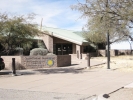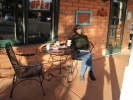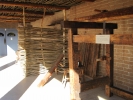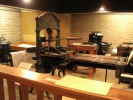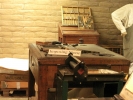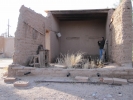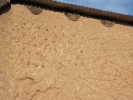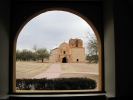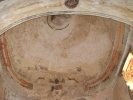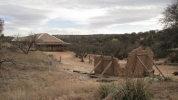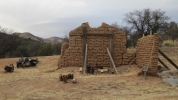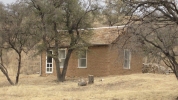01/09/2013 to 01/10/2013
This is a part of Arizona we have not visited. Driven past, but not stopped and enjoyed. Well obviously that needed to be remedied so we took a couple of days before the "big freeze" to drive down and see some sights.
Our itinerary included a stop at the Patagonia-Sonita Nature Conservancy Preserve but the weather was so bad, and our birding skills so poor, we do not have any shots from there. Maybe in the spring. However the rest of the trip worked out quite well.
- Fred Lawrence Whipple Observatory
- Tubac Presidio Historic Park
- Tumacacori National Historic Park
- Kentucky Camp Ghost Town - more or less
This observatory is the part of the Smithsonian Astrophysical Observatory and runs experiments requiring very dark, clear skies. Perfect for Arizona.
At the Visitors Center you can browse through information about the research done at the various facilities on the mountain. and see one of the 4 Gamma-ray telescopes, or VERITAS (Very Energetic Radiation Imaging Telescope Array System).
Up on the mountain there are facilities for numerous other projects like HAT (Hungarian-made Automated Telescope) to detect and characterize extrasolar planets and find and follow bright variable stars..
MMT for solar system, galactic and extragalactic astronomy..
PAIRITEL for infrared observations..
These and others are only accessible on a tour, so we think we will reserve a seat on the bus this Spring and have a closer look.
Tubac is a very nice little town with a vibrant art community but we came to view the Presidio. The nice shops will have to be explored more thoroughly on a future trip.
Tubac is a place of great distinctions. It is the oldest Spanish Presidio founded in Arizona in 1752. It has the remains of the first European settlement in what would become Arizona. It had the first printing press in Arizona. And it is Arizonas first Historic Park.
So, with all this history what does Arizona do but drop support for this amazing place. If it were not for generous and dedicated volunteers and patrons a huge part of history would be lost. Dumb, dumb, dumb.
The porch in front of the museum has been re-constructed using common building materials of of the day.
In 1691 Father Kino established Mission Tumacacori. The Jesuits administered this, and more than 20 other missions, until they were expelled in 1767 and the Franciscans managed them until 1821 when Mexico earned independence from Spain.
In 1908 President Teddy Roosevelt established the Tumacacori National Monument. In 1990 Congress expanded this to include the missions of Calabrazas and Guevavi (neither is open to the public) and declared them a National Historic Park.
Various attempts have been made to stabilize the remaining structures and still maintain their original appearance.
This is billed as a ghost town but it is not. The area saw placer gold mining until 1886 when the effort was more trouble than success. In 1904 a mining engineer named James Stetson introduced hydraulic mining to the camp and it was active until 1912.
Since then it has been a cattle ranch, used for films and was finally acquired by the Forest Service in 1989.
Some of the buildings have been restored and can now be rented out for retreats,overnight stays or other functions. The Hotel and a Bed & Breakfast are both open for business.
